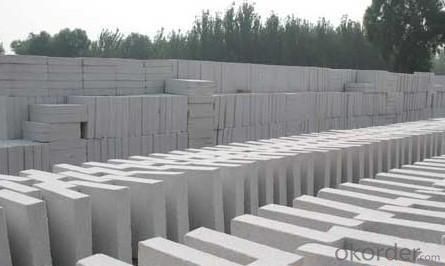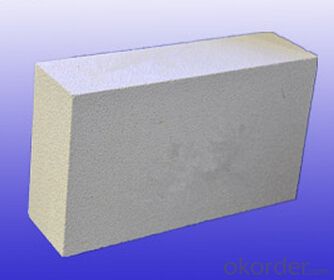Insulating Fire Brick - Refractory JM Mullite Insulation Brick B-6
- Loading Port:
- Shanghai
- Payment Terms:
- TT OR LC
- Min Order Qty:
- 10 m.t.
- Supply Capability:
- 1000 m.t./month
OKorder Service Pledge
OKorder Financial Service
You Might Also Like
Specifications
Low density.
2. Classification temperature:1610-1780.
3. Thermal insulation energy-saving effect is good.Refractory mullite insulating refractory brick JM 23
Okorder series heat insulation brick
Okorder series thermal insulation brick is an effective, energy saving, low carbon, environmental protection advanced, according to the ASTM standard manufacturing products. Okorder series products are best Li Ning and insulation in all types of industrial furnaces in the metallurgical field, aluminum, petrochemical, electric power and glass ceramic materials. They can be used as part of the working layer of thermal insulation or non - melting. Products have been widely used in the following furnace, achieved satisfactory results.
Application of heat preservation brick
Metallurgical Industry: blast furnace, hot blast furnace, heating furnace, etc..
Petrochemical Industry: ethylene cracking furnace, hydrogen production furnace, primary reformer, heating furnace, etc..
Ceramic industry: roller kiln, kiln, etc..
Glass industry: glass furnace regenerator, etc.
Carbon industry: carbon furnace, etc..
Aluminum electrolysis industry: aluminum reduction cell, etc.
Other industries: tunnel kiln, shuttle kiln, etc..
Advantages of heat insulation brick
Low thermal conductivity: more porosity will bring good thermal insulation effect, energy saving.
High crushing strength: high crushing strength, volume stability.
Low heat storage: small heat storage to absorb more heat, energy-saving effect is obvious.
Gao Chundu: iron, alkali metal impurity content is low.
The precise size: Brick size processing precision, special shape cutting and grinding, accelerate the brickwork.
Insulating brick picture


Common problem solutions
1. What products do you have?
We have all kinds of refractory bricks, refractory casting materials, mortar, cement, ceramic fiber products, etc..
Or you can browse our products to choose what you need.
2. How to control product quality?
With strict quality control system throughout the material selection and production process, we have the quality of refractory materials and ceramic fiber products to meet customer requirements.
From the selection of raw materials, the quality of our control to start. The quality certificate of the raw material is required, each batch of the products are to be tested in the use of the forward line. In the production process, the quality control by the workers, and then each piece of classification, and through the quality supervision and inspection.
3. Can you give me a brief introduction to the application of your product?
My company is mainly engaged in refractories in the steel, cement, glass, ceramics, petrochemical, electric power and other industries.
4. What information do you need if I need you?
In order to select the right products, we will provide us with information, such as the United States, technical data, order quantity, product application, etc..
If you have any questions, please contact us.
High alumina insulation brick,Insulation brick,Fireclay insulation brick
Features:
1. Low thermal conductivity.
2. High strength and resistance to corrosion.
3. Low heat capacity.
4. Low shrinkage after heavy firing.
5. High insulation.
6. High refractoriness.
7. Low density.
8. Good thermal shock resistance under high temperature.
9. Thermal insulation energy-saving effect is good.
Physical and chemical index:

Application:
Insulation brick can be widely used for lining or insulation layers of various industrial furnaces and kilns in metallurgical industry, machine building industry, ceramic industry, chemical industry.
- Q: Can insulating fire bricks be used for insulation in smelters?
- Yes, insulating fire bricks can be used for insulation in smelters. Insulating fire bricks are specifically designed to withstand high temperatures and provide excellent thermal insulation. They are made from lightweight refractory materials that have low thermal conductivity, allowing them to effectively retain heat and minimize heat loss. This makes them ideal for use in smelters, where maintaining high temperatures is crucial for efficient metal smelting processes. Additionally, insulating fire bricks are resistant to chemical attack and mechanical stress, ensuring their durability and suitability for use in harsh smelting environments.
- Q: Are insulating fire bricks suitable for use in thermal shock applications?
- Yes, insulating fire bricks are suitable for use in thermal shock applications. Insulating fire bricks are designed to withstand rapid temperature changes without cracking or breaking. They have low thermal conductivity and high thermal resistance, which makes them an ideal choice for applications where thermal shock is a concern. These bricks are made from lightweight refractory materials, often containing a high percentage of alumina or silica, which gives them excellent thermal stability and resistance to thermal shock. They can be used in various high-temperature applications such as kilns, furnaces, and fireplaces, where they are exposed to extreme temperature fluctuations. Overall, insulating fire bricks are well-suited for thermal shock applications due to their ability to withstand rapid temperature changes and maintain their structural integrity.
- Q: Can insulating fire bricks be used in the construction of foundry furnaces?
- Certainly, foundry furnaces can utilize insulating fire bricks in their construction. These bricks, composed of lightweight materials such as ceramic fibers, vermiculite, or perlite, possess excellent insulating properties. With their ability to withstand high temperatures, they are deemed appropriate for foundry furnaces. To endure the intense heat generated during metal melting, foundry furnaces necessitate materials that are heat-resistant. Insulating fire bricks, with their exceptional heat transfer resistance, effectively minimize heat loss within the furnace. Consequently, they are an ideal choice for insulating the furnace's walls and floor, thereby enhancing energy efficiency and reducing fuel consumption. Furthermore, the lightweight nature of insulating fire bricks facilitates their handling and installation during furnace construction. Their lightweight composition also reduces the overall weight of the furnace structure, making it more portable and easier to relocate, if necessary. In summary, due to their outstanding insulating properties, heat resistance, and lightweight characteristics, insulating fire bricks are a suitable option for constructing foundry furnaces. By improving efficiency and performance while enduring the extreme temperatures required for metal melting, they prove to be highly advantageous.
- Q: Can insulating fire bricks be used in outdoor fire pits?
- Certainly, outdoor fire pits can make use of insulating fire bricks. These bricks are specifically engineered to endure high temperatures, rendering them suitable for fire pit applications. They are crafted from heat-resistant materials like ceramic fibers or refractory substances, which aid in preserving the heat within the fire pit. Moreover, insulating fire bricks possess a lightweight composition and are effortless to install, making them a practical selection for outdoor fire pits. Nevertheless, it is crucial to bear in mind that these bricks may not possess the same level of durability as regular fire bricks. Thus, they might necessitate more frequent replacement if exposed to extreme temperatures or harsh weather conditions.
- Q: Can insulating fire bricks be used in both residential and industrial applications?
- Insulating fire bricks are versatile and suitable for both residential and industrial use. They provide thermal insulation, preventing heat loss and maintaining desired temperatures in various settings. In residential applications, these bricks enhance energy efficiency and reduce heat loss in fireplaces, wood-burning stoves, and kilns. In industrial environments, they are commonly used in furnaces, kilns, and high-temperature areas to insulate and prevent heat transfer. Additionally, they are utilized in constructing ovens, chimneys, and boilers in both residential and industrial settings. In summary, insulating fire bricks can be applied in numerous applications, making them suitable for both residential and industrial purposes.
- Q: How do insulating fire bricks contribute to energy efficiency?
- Insulating fire bricks contribute to energy efficiency by providing excellent thermal insulation properties, which help to minimize heat loss and retain heat within a structure. This insulation reduces the need for excessive heating or cooling, resulting in lower energy consumption and cost savings.
- Q: How do insulating fire bricks affect overall heating and cooling costs?
- The utilization of insulating fire bricks can have a significant impact on the overall costs associated with heating and cooling. These bricks are specially designed to possess a low thermal conductivity, which makes them highly effective at preventing the transfer of heat. Incorporating insulating fire bricks into the construction of a building greatly reduces the amount of heat lost during colder months, resulting in a decreased need for energy to maintain a comfortable indoor temperature and consequently lowering heating costs. Likewise, during warmer months, insulating fire bricks aid in keeping heat out and maintaining a cooler indoor environment. This diminishes reliance on air conditioning systems, leading to reduced cooling costs. The high thermal resistance of these bricks plays a crucial role in minimizing heat gain from the external environment, offering a more energy-efficient solution. Furthermore, the use of insulating fire bricks can also contribute to the long-term durability and efficiency of heating and cooling systems. By lessening the workload on these systems, they can operate more efficiently, resulting in less wear and tear and potentially extending their lifespan. This can lead to additional cost savings by eliminating the need for frequent repairs or replacements. Overall, insulating fire bricks offer substantial benefits in terms of reducing heating and cooling costs. By enhancing thermal insulation, they facilitate the creation of a more energy-efficient building, ultimately resulting in lower utility bills and a reduced carbon footprint.
- Q: Can insulating fire bricks be used in pizza ovens or outdoor grills?
- Indeed, insulating fire bricks are perfectly suitable for utilization in pizza ovens or outdoor grills. These bricks are specifically designed to withstand elevated temperatures and offer exceptional insulation properties, rendering them highly desirable for applications that demand intense heat, such as pizza ovens or grills. By incorporating insulating fire bricks, one can guarantee even distribution and retention of heat within the cooking area, resulting in a more efficient cooking process and delectable food. Furthermore, these bricks possess remarkable durability and resistance to thermal shock, allowing them to endure repeated exposure to extreme temperatures without cracking or deteriorating. Consequently, opting to use insulating fire bricks in pizza ovens or outdoor grills represents a superb choice for achieving optimal heat retention and superior cooking performance.
- Q: Are insulating fire bricks suitable for use in kilns and furnaces?
- Yes, insulating fire bricks are suitable for use in kilns and furnaces. They are designed to have excellent insulation properties, which helps to reduce heat loss and improve energy efficiency in these high-temperature environments. Additionally, insulating fire bricks can withstand the extreme temperatures found in kilns and furnaces without cracking or breaking, making them a reliable and durable choice.
- Q: Are insulating fire bricks resistant to sulfur dioxide?
- Yes, insulating fire bricks are resistant to sulfur dioxide.
Send your message to us
Insulating Fire Brick - Refractory JM Mullite Insulation Brick B-6
- Loading Port:
- Shanghai
- Payment Terms:
- TT OR LC
- Min Order Qty:
- 10 m.t.
- Supply Capability:
- 1000 m.t./month
OKorder Service Pledge
OKorder Financial Service
Similar products
Hot products
Hot Searches
Related keywords




























